More actions
| Line 124: | Line 124: | ||
===Specials=== | ===Specials=== | ||
* '''Dewamenet Legacy:''' The Asha Living Metal is inexplicably linked to their Mundane status. If an Asha becomes Occult whether through Affliction or by learning Magic, Asha no longer have access to Living Metal. The Specials / Abilities derived off Living Metal are still there, however the Living Metal is replaced with Magical Energy which is a formless glowing light of any color chosen by the player. | * '''Dewamenet Legacy:''' The Asha Living Metal is inexplicably linked to their Mundane status. If an Asha becomes Occult whether through Affliction or by learning Magic, Asha no longer have access to Living Metal. The Specials / Abilities derived off Living Metal are still there, however the Living Metal is replaced with Magical Energy which is a formless glowing light of any color chosen by the player. Additionally, Asha gain the Spell Point Buy Special Lightning Immune without needing a Spell Point Buy investment, and without being Occult. | ||
* '''Ferromancy:''' Living Metal grants the Asha greater control over Iron (not steel). Through controlling Living Metal, the Asha gain telekinesis over Iron within Emote Range, thus being able to open doors from a distance by controlling the hinges, levitating iron nails and pushing them into place, and other such aesthetic actions. | * '''Ferromancy:''' Living Metal grants the Asha greater control over Iron (not steel). Through controlling Living Metal, the Asha gain telekinesis over Iron within Emote Range, thus being able to open doors from a distance by controlling the hinges, levitating iron nails and pushing them into place, and other such aesthetic actions. | ||
* '''Dewamancy:''' The Asha have great control over Living Metal also, being able to steer it around in the air like a liquid, and shape it into any shape they like. Living Metal has a great degree of flexibility, being able to create more intricate and finely detailed designs than normal metals would. The Asha can also use their Living Metal to restart Living Metal Constructs found in Progressions. | * '''Dewamancy:''' The Asha have great control over Living Metal also, being able to steer it around in the air like a liquid, and shape it into any shape they like. Living Metal has a great degree of flexibility, being able to create more intricate and finely detailed designs than normal metals would. The Asha can also use their Living Metal to restart Living Metal Constructs found in Progressions. | ||
Revision as of 23:24, 25 September 2022
| Asha | |
|---|---|
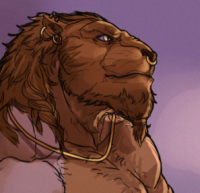 | |
| Race | |
| Pronunciation | Ash-Sha |
| Classification | Gorr |
| Subraces | Rakhet, Senef, Merew, Nefer |
| Common Nicknames |
|
| Languages | Common, Ibeth |
| Naming Customs | Egyptian |
| Racial Traits | |
| Distinctions | Feliform carnivores who try to regain their lost glory |
| Maximum Age | 140 |
| Eye Colors | hues of brown and yellow, sometimes blue and green also |
| Hair Colors | fur patterns are wildly varying between species, though refrain from too obvious colors like blue, green and yellow, instead favoring more earthly tones of ochre, brown, beige, white, black, etc. |
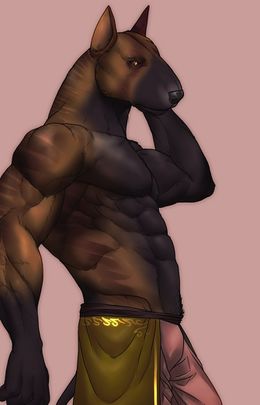
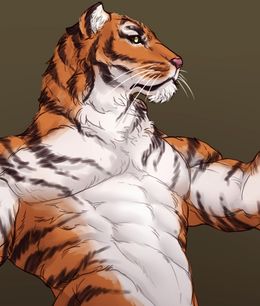
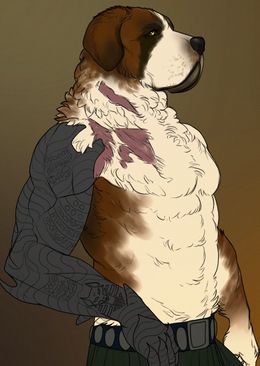
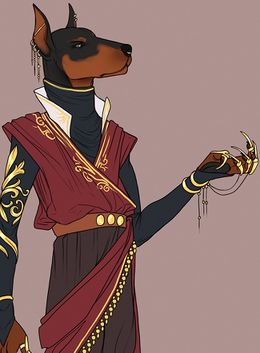
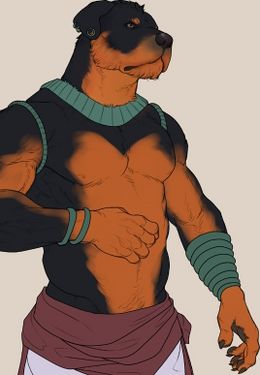
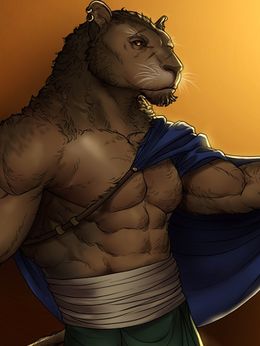
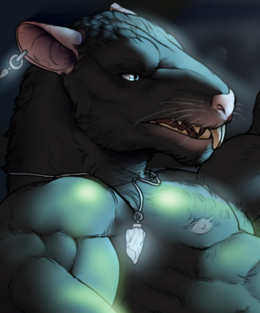
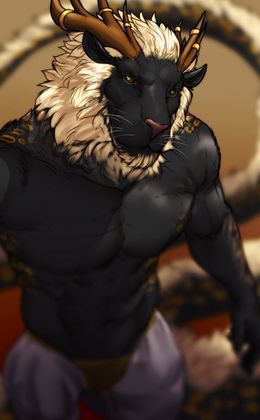
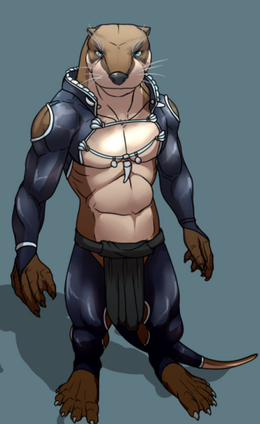
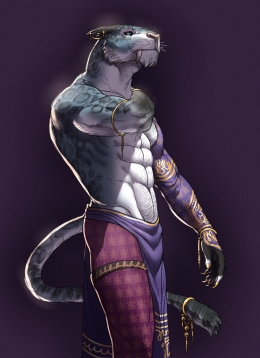
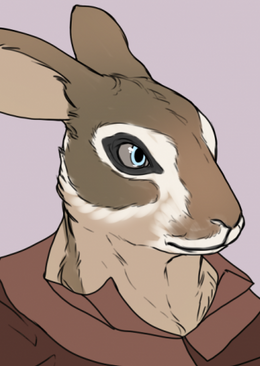
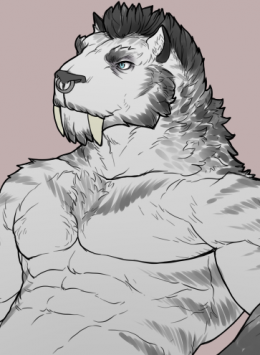
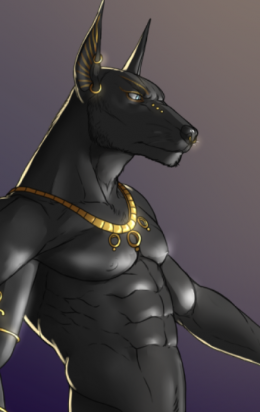
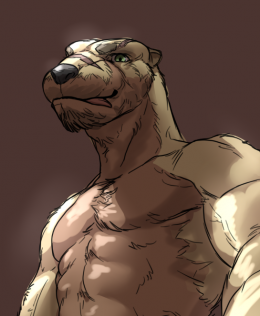
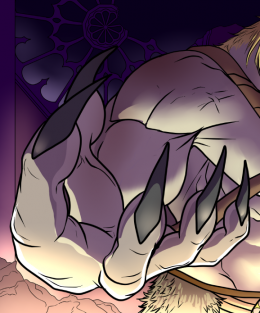
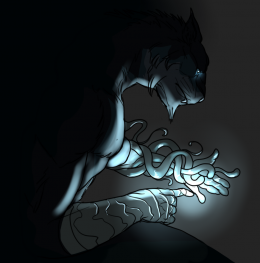
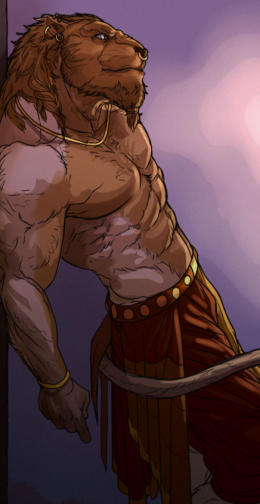
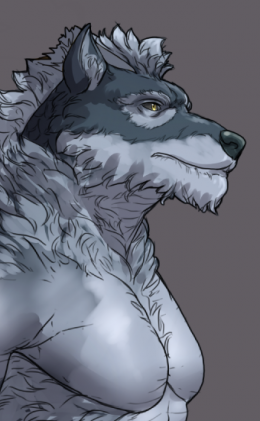
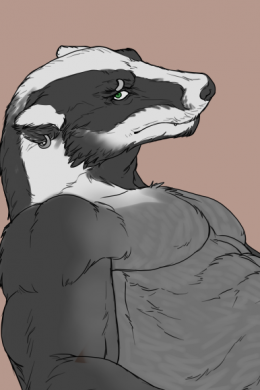
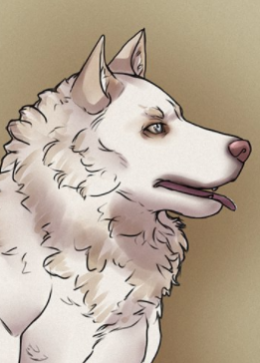
Asha, one of the oldest pre-Allorn Empire Races of Aloria, are a race of carnivorous furred humanoids that inhabit the Ashal Islands and vast stretches of the Ithanian deserts, as well as large floating city-fleets across the oceans. The Asha are known for occupying two opposite ends of the society spectrum; among the Ashal Islands they have cultivated wealthy and prosperous states, free from the centuries of Altalar oppression that was broken during the Cataclysm. And yet, many Asha still remain enslaved among the Altalar, in bondage to those who destroyed their ancient Dewamenet Empire, yearning to be as free as their brethren in the east. Fierce and communal, the Asha have learned from the mistakes of the past and their trials as slave people for over 10,000 years, creating a society that holds liberty above all, looking to the future without letting go of the identity of the past. While most of the Dewamenet Empire still lies in ruins, forgotten by time, the Asha forge ahead with a new identity of their own making, guided by the heroes of ages past and present, to show all in the world, and especially the Nelfin, that they will not be erased from history.
Core Identity
To be Asha is, at its core, to be a person from whom past heritage and glory were stolen very violently and magically, putting them in a difficult position in the modern era. With much of their history wiped out, many Asha are lost as to what their role is in the world, clinging to each other and what niches they can carve out in foreign societies to recapture a sense of identity. Others yet see this clean slate as freeing, not being bound by the expectations and norms of the past, and having little in the way of defining culture that inhibits new ideas and experimental lifestyles and ambitions. It is this last part in particular that the Asha have clung to, the idea that they were denied freedoms, dreams, and goals for centuries, and as such should taste as much of it as they can possibly get their hands on. An Asha never seeks to sit still, always seeking the next opportunity, whether that is to acquire material, sentimental, or emotional value.
Ashal Diaspora
Many of the Asha have taken to the sea, the land without claims, to live out their lives. As the Asha broke free in a relatively late stage of history compared to other Races, they had no real land to claim as their own following the collapse of the Allorn Empire, and Ailor mostly filling the gaps of territory. While the Asha have since reclaimed some of the Ashal Islands, the governors there are not fond of some of the Asha minorities, and the islands themselves have to sustain a high standard of living by only admitting a small population, meaning most of the Asha still live abroad or in large ocean-faring fleets of ships.
Recaptured Past
Asha are always piqued by hints of the past, or small clumps of history they can latch onto that reveal more of what the Dewamenet Empire once was. Every Asha grows up with tales of the great Empire they once created thousands of years ago, and how it was violently stolen from them by the Altalar who then proceeded to enslave them for an almost inconceivable long amount of time. Each artifact or discovery made of the Dewamenet Empire unleashes fervent discussions and debates among the Asha for the implications, and any new strip of information, or a chance to speak to some divine entity to discover more of the Dewamenet past is sure to invigorate any Asha.
Identity Crisis
The Asha are a Race uniquely beset by a Mundane vs. Occult identity crisis, and a wider set struggle of clan-favoritism. Thousands of years of Elven slavery has left many of the Asha changed, some permanently, in ways that others would consider lost or disfigured. While there is a general sentiment that any Asha, even Half-Asha, have the right to reclaim their heritage, some Asha find other Asha who use Magic hard to stomach, especially because Magic was used to steal so much from them. Asha aren’t hateful of Magic outside of their Race, but have a very hard time processing why any Asha would willingly give into dabbling in what they call the Dark Arts. With the strict anti-Occult stance taken by the Corsair Fleets and the Ashal States, Asha Mages have to often live in other countries that tolerate their crafts.
Design
Mental Characteristics
The Asha do not really have any unifying personality traits. For a Race that was beaten into submission for so long, any semblance of old customs and traditions have long since watered down over the years, meaning any Asha is a clean slate in terms of mentality towards the world, each other, and themselves. Perhaps the only real unifying trait that the Asha have, is pride in their fur and especially their tail. Asha can be gregarious or shy, energetic or sluggish, but between all of them, regardless how extroverted they are, one does not touch their fur without their permission, and above all one never touches their tail. It was common practice in the Allorn Empire to cut off Asha tails, and so their first recaptured sentiment is that their fur and tails are their own, and no-one may violate them without their strict consent, a freedom denied them in the past.
Physical Characteristics
The Asha can best be described as furred humanoids with heads and body parts shaped more like that of Animals than one would see in a traditional Ailor or Nelfin. The Asha are similar to Urlan in that they have the head of an animal, but the body of a bipedal humanoid, but different to the Urlan in that they are entirely covered in fur at all times, and have a much broader spectrum of appearance. Because of intentional breeding programmes endured while enslaved, many of the Asha have diversified to such a point that there is no common trend of physical appearance (despite the overbearing amount of muscular art on this page). Asha can be slender, bulky, stout, lanky, petite, voluptuous, ranging from Dwarven shortness to the tallest of Altalar height and more. There are some additional physical traits to note below.
Animal Types
The specific Animal Types available to make Asha Characters is quite expansive, but there are some limitations and expectations placed on the Players. Below is a full list of all available Asha Types:
- Canine Species: Think of Wolves, Foxes, Domestic Dogs, Wild Dogs, Jackal, Dingo, Coyote, etc. It is important however when choosing Canine Species that the Character is never mistaken for a Werewolf-like Marken.
- Rodent Species: Think of Rats, Bats, Mice, Possums, Meerkats, Minks, Badgers, Chinchillas, etc. It is important when choosing Rodent Species that the Character doesn’t become a Skaven mockery.
- Feline Species: Think of Tigers, Lions, Leopards, Cougars, Jaguars, Ocelots, Sabretooths, etc. This also includes Domestic Cat species like Tabby Cats, Maine Coons, Siamese Cats, practically any Cat species.
- Bear Species: Think of Pandas, Polar Bears, Brown Bears, Grizzly Bears, Black Bears, etc. Important to note that Humanoid proportions remain in effect and being a Bear does not grant Combat Rp advantages.
- Other Species: A list of other less categorical species are also available like Kangaroos, Koalas, Horses, Deer, Sheep, Hyenas, Otters, Primates like Gorillas or Lemurs, Beavers, Donkeys, Okapi.
- Hybrid Species: Asha can produce Hybrids of any of the animal types above. This can include combinations like Wolf/Fox, Cat/Fox, Fox/Rabbit, Tiger/Raccoon combinations, etc. Only ever a combo of 2 Species.
If unsure if a Species is acceptable while not mentioned on this list, as this list is fairly strict, please send in a ticket to the Ticket Bot on the RP Community Discord. When Asha reproduce with different Species, children are born with 80% chance of the species of either parent, and 20% chance of a completely random species from the list above. Same species parents reproducing always results in the same species children.
Fur Patterns & Colors
Asha Fur Patterns and Colors can be varied and wild. They can have the traditional fur patterns and colors of the species such as for example orange and white fur on black stripes of Tigers, but fantasy colors are also possible, for example a black-furred tiger with white stripes and brown spots. Patterns that do not occur on specific species can also be used, for example Zebra white fur and black stripes on an Otter Asha. The only limitation here is that the colors do not become excessively vibrant. For example, a Fennec Asha with a gentle soft pink or mint-green fur and white belly patches is acceptable, but not a hot-pink and cyan-blue Horse Asha. It is always also important that skin colors do not allow for a Minecraft Skin to be misidentified as a different Race. When for example dabbling in greens, make sure the Minecraft Skin does not get mistaken for a reptilian Allar. Asha Eyes are fairly varied. They can have either white, gray, or black eye whites, while their pupils can be any shade of blue, green, gray, brown, or yellow.
Half-Asha
The Asha have a unique attitude towards the Half-Asha, in that they consider the Half-Asha full-blooded members of their Race, even if they look very little like them. Half Race characters select a Dominant parent, and take all the Racials & Specials from that dominant parent. (In this case, a dominant parent Asha would be Half-Asha) Half races must have a majority of their physical features come from their dominant parent, including which is including but not limited to skin tone, hair or fur color, ear shape, or eye color. Half-Asha can reproduce with any Race that can also reproduce with other Races, which will always result in Half-Asha called Feka Asha. Feka Asha take traits from their non-Asha parent, so if the mother is a Fox Asha and the father is an Ailor, the Feka-Asha child would for example have fox ears, fur on the arms and legs, and a fox tail, with Asha eyes. While players have a lot of liberties when it comes to designing what traits Feka-Asha inherit from their Asha parent, the Lore Staff asks the players to please respect the design of the race and not dilute physical traits to the point of non-recognition. What this means is that a person who looks presentably just like a normal person, but with Bunny ears on top of their human hair, is not a Feka-Asha. A person who has only whiskers, cat ears, and cat claws, is not a Feka-Asha. These aesthetics are easier to reproduce with Mutations. Minecraft Skins should always be able to read that a person is a Feka-Asha, and if the animal-like traits on the person have been reduced to the point of single-traits, then a Character is not a good Feka-Asha design.
Summary of Racial Abilities
Racial Abilities are generally a set of unique powers and effects that all peoples of that Race all innately have, while Specials are more passive, aesthetic focused capabilities. Specials are defined per-page, while Abilities can be searched on the Ability List page to determine their generic function. Asha have a mix of Abilities and Specials themed around the Dewamenet history, their legacy, and the Ashal States, as well as their more bestial anatomy. Half Asha have access to all Abilities and Specials also.
Abilities
| Ability Name | Ability Type | Ability Range | Ability Description | Modifiers |
|---|---|---|---|---|
| Body Claws | Morph Power | Self | Grants the user Body Claws | Asha Modifier |
| Asha Speed | Constant Passive | Self | Grants the user Asha Speed | N/A |
| Higher Speed | Toggle Passive | Self | Grants the user Higher Speed | N/A |
| Warring Metal | Summon Power | Self | Grants the user Warring Metal | N/A |
| Aiding Metal | Trigger Passive | Self | Grants the user Aiding Metal | Asha Modifier |
| Intrusive Metal | Instant Power | Emote Range | Grants the user Intrusive Metal | Asha Modifier |
Specials
- Dewamenet Legacy: The Asha Living Metal is inexplicably linked to their Mundane status. If an Asha becomes Occult whether through Affliction or by learning Magic, Asha no longer have access to Living Metal. The Specials / Abilities derived off Living Metal are still there, however the Living Metal is replaced with Magical Energy which is a formless glowing light of any color chosen by the player. Additionally, Asha gain the Spell Point Buy Special Lightning Immune without needing a Spell Point Buy investment, and without being Occult.
- Ferromancy: Living Metal grants the Asha greater control over Iron (not steel). Through controlling Living Metal, the Asha gain telekinesis over Iron within Emote Range, thus being able to open doors from a distance by controlling the hinges, levitating iron nails and pushing them into place, and other such aesthetic actions.
- Dewamancy: The Asha have great control over Living Metal also, being able to steer it around in the air like a liquid, and shape it into any shape they like. Living Metal has a great degree of flexibility, being able to create more intricate and finely detailed designs than normal metals would. The Asha can also use their Living Metal to restart Living Metal Constructs found in Progressions.
- Steam Control: The Asha have a great deal of control over the temperature of water, both ambiently, and within close proximity to them. The Asha are able to flash-boil any liquid on them, causing it to instantly evaporate. Additionally, they can flash-boil any larger amount of liquid near them, causing it to instantly develop steam. Steam never hurts an Asha, nor does dry heat. This liquid boiling cannot be used to harm others or in Combat.
- Body Vent: The Asha are capable of some degree of control over their body’s size through steam eruptions. By venting a great deal of heat from their body, Asha can either lower their Body Shape (becoming more slender, shorter) or increase it (becoming taller, more muscular). This is purely aesthetic and confers no Combat Advantages.
- Sulfur Control: Asha claws have curious sulfuric attributes. When struck against hard porous surfaces like stone or metal, they produce a flint-and-steel like spark, thus being able to ignite cigarettes or small tinder. If an Asha claps their hands together quickly, making the nails touch, they can produce harmless gunpowder explosions that produce a loud clap, flash of light, and puff of smoke. Flicking their nails can also produce a firecracker-like effect. This cannot be used to obscure vision in Combat.
- Predator Vision: Asha have night vision in dark environments and at night, giving them perfect vision in darkness. This allows them to see even in low light environments inside, but does not protect them against Ability based Darkness. Asha also have excellent depth vision, allowing them to snatch for example buzzing flies from the air with ease.
- Deathspeech:Asha are capable of speaking and understanding Death Speech or Shadetongue either when it is spoken by Ordial Entities, or by others. Death Speech is a unique language because it cannot be learned the traditional way, only specific Races and Afflictions have access to it. Additionally, it is also a language that has no defined alphabet and cannot be properly read, the runes and markings varying between the cultures and Ordial cults that use it, though it is always identifiable as Deathspeech. It also defies being recorded, as the sound just becomes gibberish when any type of recording medium is used to try and replay it, even memory Abilities.
- Feshawatmancy: The Asha can also control a substance called Feshawat, which is similar to living Metal, except see-through and made of glass. Additionally, they are only able to steer it and shape it while making physical contact with it, but otherwise it behaves like Living Metal. Feshawat is fragile and despite its liquid form, can be shattered with weapon impact. The controller can also give it any color they like, or any texture or inner material like glitter or color ribbons within the glass-like material like glass marbles.
- Asha Aesthetics: Asha tend to not use magic, but if they do, it is mostly Ordial in nature, and usually have aesthetics based on funerary rituals. They are more inclined to Engineering, and Living Metal.
History
Asha history dates back long before even the Allorn Empire; it is not exactly clear how long, but most scholars agree that the Asha were not around during the Meraic Civilization and likely rose to prominence immediately after. There exist an incredibly small number ofrecords from Pre-Allorn Altalar encountering and skirmishing with “metal bending felines and canines", and the great Ziggurats of the Asha States, which are also mentioned in scouting reports from just before the rise of Talea. What is understood of this truly ancient time is that much of the known world around the supercontinent of Daen (including Ithania, Daendroc, Hyarroc, and Teled Methen) was roughly equally divided between the Allorn Empire and the Dewamenet Empire. While the Allorn Empire praised and advanced the arts of Magic, the Dewamenet Empire advanced the arts of Technology, and in fact had a very harsh stance against Magic from the outset. Finding specific dating for the beginning and end of the war between the Dewamenet Empire and the Allorn Empire is nigh impossible, as the Altalar underwent great efforts attempting to erase any notion of the Dewamenet Empire from history to force the remaining Asha into endless and hopeless servitude. It is however known that the conflict lasted for several centuries, with decades being spent fighting over mere miles of no man’s land. It is said that the Dewamenet had large crawling scarabs and scorpions as tall as mountains that bellowed fire, and regiments of soldiers that lined up with tubes casting fire and brimstone, echoed by loud thunderous bangs in rapid succession. What else is known is that the latter half of their conflict was very much a losing war for the Allorn Empire, whose presence at the front line near Ithania was driven back severely. Through some intervention however, which the Altalar claim came from the Avatars of the Gods, the Dewamenet army was crushed and their High Wall defences crumbled, giving the Altalar a clear path into the heart of the Dewamenet Empire.
The Dewamenet Empire fell swiftly after the Great Wall was broken, with terrible Magics being used to break down their cities and temples and enslave their people. The destruction of heritage and history was so profound that researching anything about the Dewamenet people in the modern day is immensely difficult; murals, libraries, and places of worship were destroyed with brutal indiscrimination, and even oral tradition was erased by the early Allorn Altalar, whose intent was unquestionably to utterly eradicate the culture, history, and collective mindset of an entire people to force them into unending slavery. The Rakhet Asha that resisted were killed in the millions, while others were given tasks most suitable to their field. It is said that many of the Asha eventually grew shorter and more diminutive over time, leading many to assume that what is commonly known as an Asha nowadays is in fact a smaller version of the Dewamenet Asha that existed over a thousand years ago, a cruel sort of ‘domestication’ that only the stature of the Rakhet survived. Some smaller groups of the Asha, notably the Siwath-Khenu or coastal tribes went into hiding, preserving only a fraction of the knowledge of Living Metal and the old Dewamenet infrastructure, but remaining instrumental in the revival of the Ashal Islands centuries later.
The Asha that lived in the Allorn Empire after that had a truly wretched existence. Especially during the Mage Wars and the Floundering, the abuse towards the Asha became so severe that in some cities, the number of enslaved Asha dead by ritual sacrifice, gladiatorial combat, or simple, brutal neglect vastly out measured the number of Asha being borns. The Asha of today know very well that their modern society is built upon the untold suffering of millions upon millions of Asha who died in the deplorable conditions under the excesses of Altalar society that feasted their boredom on the defenceless and enslaved Asha. Enslaved Asha were also mutilated by their Allorn masters; like domestic cats, they were cruelly de-clawed in their youths, with some even losing their teeth or ears; others were stripped of their tails to destroy their social cohesion and prevent silent communication; others still were even more brutally disfigured, losing their tongues and eyes for the crime of looking at their master the wrong way. Throughout the centuries, the Altalar perception of the Asha declined incredibly; though recognised at least as thinking beings in the earliest days of Allorn dominance, by the Floundering, the Asha were treated as less than disposable, seen with the same ire and disgust as a domestic animal. Any Altalar household usually had upwards to fifty Asha slaves, many of whom had been so thoroughly bludgeoned into submission that their life was a monotonous repetition of the same activities, so cruelly abused that they kept on their misery without protest.
When the Cataclysm and the Wildering occurred, however, the Asha were granted an unusual, and undeniable opportunity- and one that was only heightened by their single remaining inherited secret; Living Metal. Though forbidden by their Altalar masters, the Asha continued to secretly practice the old skill of the Dewamenet, and found a great surge in power as the land around them came apart; beneath great shields and shelters of shining Living Metal, the Asha watched on as rubble and malicious greenery tore the Altalar and their cities apart. The roles had reversed now, with the Altalar, wounded and crying out for help left, or in many cases made, to suffer before their inevitable deaths in the ruins of their towers and estates while their slaves freed each other and fled. The retribution of the Asha upon the Altalar population was just as devastating as the Eronidas Invasion had been, but is one that is rarely if ever referenced in Altalar texts; that the greatest, most devastating victory of their history had been utterly undone and wrought back upon them in the absence of their Magic is a fact that many Altalar struggle to accept, if at all they acknowledge it, even in spite of the breakdown of their slave system and the very real deaths of hundreds of thousands of Altalar in that breakdown. Not all slaves escaped however; the far southern states fared better in the Wildering, with many hundreds of thousands of Asha remaining enslaved, as with the Sollerian Altalar who were completely unaffected and could rely on their martial caste to keep the slaves in line even as their Magic failed them.
As the Asha broke free, millions of them moved east in the hopes of finding any remnant of the Dewamenet Empire as the tales had been told by the Siwath-Khenu who came out of hiding and sought out their freed brethren on the eastern coasts. The Great Journey, as the Asha told it, was a 3 year procession of massive caravans of Asha, some tens of thousands with supplies and families, who traveled along the crumbling roads of the Allorn Empire to the east, eventually all arriving in Bestaal, where one last Dewamenet gateway to the Ashal Islands existed; what was once a surviving monument of Allorn victory over the Dewamenet, would now be the gateway to the Asha’s freedom. Hundreds of Thousands of Asha formed living metal bridges together, allowing their people to travel across the ocean to the Ashal Islands, re-colonizing them one by one, re-activating the Dewamenet infrastructure, the Mewer Pyramids that burst forth the irrigation waters, the Aphed sanctuaries that once more were home to the Aphed storks, and the Khem-Henqet mills, creating power in the Living Metal tubes that brought life and air in the cities, blowing away the sand and revealing beneath the gardens that would within 10 short years once again house the lush waterfall gardens, growing plants like the Mew Hesep as it out of nothing. The last piece of infrastructure, yet arguably the most valuable to be restored, was the Vault of the Dead, heralding the return of The Sefakhem, the “cult of the dead”, and the way for Asha to bury their dead, commending them to the afterlife. With death and life alike returning to the land, animals returned in the wake of nature’s flourishing besides some animals that had survived on the islands since the days of the Dewamenet Empire, like the Taraq and the Turbahakh, finding an easy environment to take hold, as the Ashal Islands did not have any natural predators except for the Torat-Nekh that lived in the deserts in large numbers.
Though the Ashal Islands were a safe haven for the Asha, they were nonetheless still under constant threat by other Races. For nearly a hundred years, the Ashal Islands were under continuous attack from the Altalar attempting to re-establish control, as well as Velheim raiders and Daenshore encroachment from the recently liberated Ailor slaves who grew jealous of the lushness and fertility of the Ashal Islands, a stark contrast to Arvost and Kilarallis which were effectively dead stone islands. The worst of them was the Battle of Awanath Cliffs where, although casualties were low, the Asha finally destroyed the last Altalar slave fleet, which prevented any further raids, thus buying the Asha more peace of mind. The Asha remained a relatively small population, attempting to liberate their still enslaved brethren leading to nothing as the Altalar had meanwhile regained their control over Magic, and could fend off the Asha Fleets. As the Regalian Empire encroached with its larger fleet and more and more Ailor settled into the regions, the Ashal Islands became more isolationist, with only the Corsair Fleets venturing out to capture what the islands could not be self sufficient in. The Asha consciously played no important part in any of the world events leading up to the modern era, as they mostly tended to the damage done to their lands by the Allorn war millennia prior, and recover their population, which was bolstered yet further by enslaved Asha who had heard stories like Esraa's Odyssey, fleeing to the Asha States to be free and join their people.
On the cusp of the 4th century BC, the Asha were the first race to join the Ailor in the so called Crown Alliance in response to the Magic Covenant that formed between the Songaskians and the Altalar, with a stringent alliance of the Sihai in the far east. The Asha knew that if the Songaskians and Altalar united in an attack against them, the Ashal Islands could not hold, and the Ailor, although an enemy of theirs for some time, were considered a more distant enemy and therefore a closer ally. The few years since have greatly improved relations between the Asha and the Ailor, especially following the Ailor ban on the enslavement of Asha, though Asha born in or imported in slavery were not freed,, and started adopting political ideals that the Asha themselves had already accepted many decades prior. The Asha Corsair fleets still remained independent from the Regalian Empire, but the Ashal States had finally agreed to relinquish foreign policy to the Empire at large, believing the common alliance of all federal states under the Regalian Emperor could finally afford them the peace to revive much of the Dewamenet history and culture. Indeed, the Asha played a vital role in supplying the Regalian armies during the Altalar-Regalian War, and continue to supply some of the more useful ores to the Empire that are rare finds elsewhere, also starting irritation supply projects across the poorer regions of the Empire to aid Ailor population growth. Many Asha also moved to the Regalian capital, selling curiosities and providing uniquely Asha hospitality. While some suspicion from the Asha still exists towards the Ailor, their alliance with the Ailor and Allar has done them much good, and as such, they have earned and continue to advance a strong political position inside the Empire, even if they do not pay taxes or send troops to any of the Empire’s conflicts. Nefer Asha continue to remain present in the highest rungs of Ailor society, gently steering policy into their progressive directions to create a better world for everyone involved not through slavery or submission and conquest, but through standard of living and co-operation.
Culture
Asha culture can best be described as a culture that maintains elements of the past, the Dewamenet Empire and what the modern Asha assume was an autocratic system, while implementing a high standard of living and a very progressive way of life. The Asha in general live the “live and let live” mantra, believing strongly in the Bastar faith concept of Kharma, and believing in the social liberation of others not through conquest, but through cooperation. The Asha States are the only known entity on Aloria that has outright banned slavery of any kind, and any slave who is lucky enough to land on Ashal territory is immediately freed and given social housing. The Asha States are nations that do not strictly know the concept of poor or rich, as they all live in a communal society with free housing, no taxes, and only minimal economic bartering while what the Asha call “inalienable rights" such as a roof over one’s head, food, water, and leisure are all free for their people. Such a utopia would indeed not be possible without the communal suffering that the Asha went through during the Allorn Empire, as well as their command over Living Metal in the Ashal States, where the ancient Dewamenet infrastructure and technology supplants the need for a labor workforce. While capitalism and finance have been slowly introduced to their society through the alliance with the Regalian Empire, the Asha have relegated such activities to so called Fair-Ports, port cities where finances and taxes are a thing, but where Asha opt-in to these activities. The Asha are not naive to think that the whole world could live in such peaceful conditions as they do at home, with their needs taken care of by technological machines that somehow still work after 1000 years of being buried under the sand. They know very well that the world outside their islands is far more cruel, and that if they shared too much of what they had without properly securing it first, that they too would fall to rampant poverty and conflict. As such, the Asha are welcoming and kind to visiting guests, but suspicious and deterring to staying immigrants. Foreigners may only live in the Fair-Ports, and mixing with other races is strongly discouraged. That being said, many Asha also have a lust for adventure and grow bored of the ever-peace of the Asha States, venturing out on the high seas as Corsairs, or into far-away lands as explorers, becoming part of other societies and tasting the wealth and entertainment other places have to offer. Other Asha yet discover the wealth of commerce outside of their realm, developing an appetite for trade and becoming much wanted business owners across the Regalian Empire. And finally, many Asha have a burning vengeance for the Altalar that inflicted so much pain on them, or if not the Altalar, then at the very least the Kathar, signing up for the Regalian Military and making a living out of war.
Language and Dialects
The Asha speak a Language called Ibeth, but is almost certain that Ibeth was not spoken by the Dewamenet, and is rather a more modern language developed upon the interpretations left behind by the Dewamenet writing on the Ashal Islands. As such, the Asha language has a written alphabet of hieroglyphics that dates back from the Dewamenet era, but a spoken language and phonology that is entirely modern. The Ibeth language has no common ancestry with any other language across Aloria, and is purely made out of what little words the Asha remembered after 1000 years of slavery with the context of writing applied on top, and the gaps filled in by more intellectualy inclined Asha. Ibeth sounds fairly guttural, with soft g’s and ch’s and hard kh’s and dh’s, interspersed with many vowels. In terms of pronunciation, Anglian and Etosian Ailor have an easier time pronouncing and learning Ibeth, but an Asha can always tell whether someone is a foreigner because of the difficult resonant intonations of their consonants. Ibeth is spoken across all subraces far and wide, and even the Siwath-Khenu tribes have adopted Ibeth as a means to stay close to the other Asha, even though they likely spoke a diminutive form of Dewamenet language that has long since died out again. Dialects effectively do not exist among the Asha, because all parts of Asha society are strongly linked together in celebration and communion. Even across state borders, the Asha barter and carouse quite a bit, and as such, dialects that spring into existence never survive for long before they are brought back to the mainline Ibeth standard. Due to the guttural intonation of Ibeth, Asha may have trouble not over pronouncing ‘r’, ‘z’, ‘k’, and ‘d’ sounds when speaking other languages. The Ibeth language is based on real-world Ancient Egyptian, while naming principles follow the same language. It is more common for Asha children to be named after items or events or things that played an auspicious role on their birth. For example, despite the fact that a subrace is called Nefer, the word Nefer also means beauty, so a child born with striking beauty may be called “Nefer” also, while a child born with a cold sniff might be called “Tepi”, which is the “Ibeth” word for sniff. One that walks early may be called “Ahat”, meaning standing, and one that is strong in battle may be called “Keded”, meaning slaughter. Asha parents or sometimes even Asha themselves may change the name of their child or in adult years to something else if they feel more strongly associated with that particular name. Asha surnames are always based on their gendered parent - for example - if a girl born in sorrow from her mother Herep dying in childbirth, she may be called Ianew daughter of Herep. Daughters are named after mothers, while sons are named after fathers. Rulers and priests tend to extend their names, with “-hotep” being a common suffix for a male of high respect, while “-amun” fulfils the role for females of high respect.
Politics
Asha politics is centered around the autonomous Asha States, and the Asha Fleets, which are nation-states in name without actual land to call their own. Before the defeat of the Asha at the hands of the Allorn Altalar, the Asha were unified in the Dewamenet Empire, a state spanning most modern day Lusits, Daenshore, Ithania and the Asha Islands. After the defeat of the Dewamenet Empire, the Allorn destroyed the vast majority of the Asha infrastructure and technology on the Daen mainland, but left the Asha Islands relatively untouched due to their perceived low economic value. As soon as Asha technology ceased to function when the war was lost, these islands became sun-scorched desert hellscapes with no fresh water or valuable resources to be harvested. The shifting sands eventually caused much of the architecture to be buried and thus spared from the rot of time. When it was time for the Allorn Empire to fall, millions of Asha moved eastward to the Asha islands, slowly re-discovering and re-activating the millennia old technology that was buried under the sands, re-activating what the Asha call “Mother’s Life”, or the vast underground network of water pumps bringing life back to the desert islands, and establishing the Asha States. The Asha States chose independence from one another as the time of Empires had long since past, and their isolation from one another had turned many of their people strangers to one another. Still, the Kings and Queens come together once every three years in the so-called “College of Mother’s Hands", where they discuss Asha politics along with the Corsair Lords and Ladies of the Asha Fleets. The Asha States are part of the Regalian Empire by treaty of association to the Crown Alliance, but do not formally subscribe to State Law, or State Taxes. There is in fact no agreement or cross-border relation between the Asha States and the Regalian Empire, besides a loose commitment to a common foreign policy, and the fact that the Asha accept Common as an acceptable language and the Regal coin as legal tender. The Asha Fleets in contrast to the Asha States, are nation-states without land. They each have a societal structure with their own law and hierarchy, atop of which sits a Corsair Lord or Lady. These Asha Fleets have specifically done away with land claims, believing that settlement makes them vulnerable to slavery, and thus have embraced the lawlessness and movement of the open waters. The Asha Fleets move around frequently, but are commonly found in the waters anywhere between Nordskag and Hadar, though sometimes also venturing further west to Etosil or even the Regalian Archipelago. The Asha Fleets are not part of the Regalian Empire, and largely ignore Regalian authority or military forces whenever they can. In past centuries, Asha raiding was a considerable problem to Regalian shipping, but since the recent inclusion of Asha States into the Regalian Empire, the Asha Fleets have largely been pacified through the soft political pressure exuded from the College of Mother’s Hands, where the Kings and Queens ensure that their Corsair Lords and Ladies don’t antagonize the Regalian Empire and complicate their own domestic politics. As such, the Asha Fleets have largely started targeting Songaskian, Dwarven, and Kathar shipping for raiding, though coastal raids against Lusits and Ithania also sometimes occur, the Asha Fleets largely getting away with this because the Regalian Empire would prefer not to further antagonize the Fleets into open war. Despite their separation, the Asha States and the Asha Fleets do have economic contact with one another, and do also share common religious festivities. It is not uncommon for Asha Fleets to visit the Asha States on rotation, with each of these States having one so-called Moon-Port, massive port facilities capable of handling the thousands of ships that Asha Fleets tend to come with. The following Asha political entities exist:
- The Queendom of Bestaal is the only Asha State that is positioned on the mainland of Daendroc, and also the only Asha State that does not have considerable Asha Technology present. It is the only Asha state built out of the husk of Altalar cities, and while it has a considerable military, it is relatively poor compared to the other Asha states and has numerous other racial minorities. The Queendom of Bestaal is ruled by Queen Sekhnehettem II.
- The Queendom of Azzol is the smallest Asha State both in landmass and population. This Asha State focuses strongly on the religious needs of the Asha Fleets, and as such has many temples all across its landmass, with its capital essentially being one massive temple of the dead, where the Asha Fleets deliver the coffins of their dead who were lost at sea to be processed and buried in the necropolis mastaba (tomb houses). The Queen of Azzol is ruled by Queen Azsamakh III.
- The Kingdom of Ssil is a powerful Asha nation with a large population of Rakhet Asha, ruled by a Rakhet king named Kazhotep IV. The Kingdom of Ssil has most commonly engaged in military conflict with neighboring Basqlierra and Massif, and continues to sword rattle with these Ailor nations that are often just a quick transport fleet away from their coastlines.
- The Brother Kingdoms of Pharah, which are Memphiza, Gizkh and Therasu are the richest and largest Asha States all ruled by one King named Neb-Ram-Assehs II. These brother Kingdoms were once independent, but following three of them falling in the hands of Queens that were all the same age, these Queens made an agreement to marry each other’s husbands to form an ironclad alliance and to merge their customs and liquify the borders between them. They then agreed that the first born child of any of them would come to inherit all Kingdoms, causing the first born son of Queen Clehet-patra IV to become the King of all three unified Kingdoms, adopting all other children from any of the Queens that went before him into his own family as siblings, effectively unifying the three Kingdoms. The three Kingdoms continue also independently be the wealthiest Asha States, as Memphiza produces the majority of the marble for the other states, Gizkh produces the majority of the gold from its many mines, and Therasu has control over the ancient libraries of Therep, where all Asha who learn about Asha technology go to study.
- The Queendom of Kharkoor is the greatest friend of the Asha Fleets, and the majority of Kharkoor is employed in the production of Corsair ships and naval supplies. Kharkoor’s forests are a well guarded secret of Asha technology irrigating tree sapling farms from which they dispense their endless wood supplies to the many repairs and ship purchases. The Queendom of Kharkoor is ruled by Queen Nefw I.
- The Kingdom of Nakhoor is also called the Life-Forge Kingdom, which is where the majority of the Living Metal infrastructure of the other Kingdoms is maintained. The reason why unity among the Asha is not fully possible, is because all states fear Nakhoor falling in the hands of any political rival or ally causing that entity to become too strong. As such, Nakhoor is the linchpin that keeps all the other Asha states independent and not at conflict with one another, since Nakhoor also has the means to shut off the living metal irrigation of the other Kingdoms remotely.
- The Medes Corsair Fleet is an Asha Corsair fleet mostly active around Songaskian and Hadravian waters, though frequently taking a once-yearly trip back to the Asha States for supplies and religious festivities. The Medes Corsair Fleet has become very adept at coastal raiding instead of boarding, feeling right at home in the desert sands of Farah’deen. The Medes Corsair Fleet has no single leader, but is led by two Senef Asha lovers, Lady Saalamun and Lady Vasnaf.
- The Sefetjew Corsair is most commonly known for Commander Kahnef (commonly also called Kahn among Ailor), or the “Demon Claw” as he was also called by his victims. The Sefetjew Corsair Fleet is extremely hostile to all foreign entities and still frequently engages in military conflict with the Regalian Fleet if they feel they have found a target that is easy pickings. They continue to raid Ithania, Kilarallis and Daenshore, while occasionally venturing to Etosil. Unlike commonly assumed. The Sefejtew is in fact not led by Commander Kahnef, but by Lord Maswuhotep.
- The Kheni-Hetef Fleet was once a Corsair Fleet, but has largely become more pacified due to their agricultural shift. The Kheni-Hetef discovered a way to use Living Metal to purify and irrigate with seawater, allowing them to build floating farms and thus rear livestock on the seas. The inclusion of aquatic Allar into their fleet due to numerous trips to Hadar diversified their society, and even Dwarves joined them for the curiosity of Living Metal and their expeditions to faraway lands discovering new materials. The Kheni-Hetef Fleet moves around a lot, but usually anchors in the north of Hadar to remain in close proximity to underwater communities of Allar. The Kheni-Hetef Fleet is ruled by Fleet Lord Ammunakhonet, who is rumored to be four hundred years old, and covered in whipping scars from his time as an Altalar slave. The Fleet Lord constantly wears an ornate feline mask and is so decrepit that he is moved around on a palanquin by his bodyguards; despite this physical frailty however, Ammunakhonet commands great authority and respect among the other Asha royals.
For more information about the Asha states, refer to the Asha States page, and the Brother Kingdoms of Pharah page.
Religion
The Asha religion, the Faith of Baskarr, can be read about in detail on the Baskarr page.
Fashion
Asha clothing is often very simple in its application of garments yet rich in texture and patterning. Beyond a simple chest cloth worn by women and leather straps worn by men to attach objects to, Asha rarely wear any clothing on their upper body when they don’t seek a reason to blend into human society. Male and female Asha alike, all wear a so-called Satoor, a dress-like clothing piece often in earthen or burgundy color tones with a variety of intricate patterns in vibrant colors that spans from the waist to the ground. These Satoors are often specially tailored to allow a tail to protrude from the back, and also have individual cuts on the front and sides to allow a free range of motion for Asha in combat. The Satoor is, in fact, a crucial piece for many cultural traditions of the Asha. As part of decoration for the Satoor, high officials may also wear shoulder capes or shoulder pelts from Muff-oxen. Jewelry is also a very much prized accessory for all genders of Asha, with numerous necklaces and ear piercings being the norm in adults. One important cultural expression involving the Satoor is the Satoor-Bis Kahnar Hakkar, a wild dance performed by Asha to court other Asha. The dance itself is carried out with leaps involving fierce snarling expressions, grunting, chest beating and wild waving of claws, where the purpose is also to make the Satoor flow with poise and grace, in contrast to the wild and savage expressions. The primary use of the dance is to impress a potential partner with an Asha's strength, though Asha also perform it to intimidate enemies before battle. This is why the boundary between enemy and passion are very thin for the Asha, and why the “enemy turned lover” is a frequently seen romantic trope among the Asha, impressed with enemy soldiers or warriors in battle that they fall for them. The Asha also have a fabric that was once unique to them, made by the Hemat Clade living near coastal regions, but has since been more widely produced by other Races when the Asha sold it in their Fair-Ports, though 9 out of 10 of these clothing pieces are still made by Asha. They produce their Elastan clothing (a form of Lycra), which is made in dark blue hues from the natural Elastan thread excreted by a particular type of coral. The fabric is inherently liquid deterrent, but can be dyed for those who spend a lot of time infusing the dye over and over. Their Elastan clothing usually covers their arms and shoulders, as well as their legs and waist, but does not cover their torso. Elastan eventually also was mixed with other fabrics, creating Peltastan. Peltastan (as a form of woolly spandex) has similar properties as Elastan, being form-fitting and soft, but Peltastan is not water detergent, and is more matte and soft than Elastan. As opposed to just a Satoor, Peltastan is usually worn on the torso and upper leg area, while a half-satoor is worn over it like a battle skirt, often with shoulder pads to boot. The Asha recognize the difference between a civilian Satoor, and a combat Satoor, which cuts off at the knees. Asha effectively do not wear armor, and besides the shoulder guards which are mostly meant decoratively, go to battle wearing very little to benefit from their superior agility over other races.
Cuisine
The Asha have a very simple and rich diet comprising of mostly meat with spices, eggs and dairy such as cheeses and yogurt, it is seen as most disgusting and difficult to stomach among outside goers of the race, however, to the Asha it is the same as an Anglian eating grain. Their main and most favoured main staple is meat eaten either raw, cooked, and cured, consisting of geese, quail, pigs, cows, mutton and lamb and any fish that can be caught. The meat is eaten in a variety of ways, and no part of any animal is wasted among the Asha, including the blood. The Asha make use of eggs and yogurt in breakfasts and lunches, using eggs, oil and vinegar to make an emulsified spread over a simple pan-fried flatbread. It is a minority food accompaniment but the Asha do in fact eat grains in the use of bread to soak up any juices and drippings from their meat dishes not leaving a single scrap left on their plate. They eat raw meat and fish most often in the afternoon, raw meat, eggs and cheese is an often welcomed sight for the worn-out and hot Asha working on the fields, tending the farm or hunting game. A favoured afternoon dish for the Asha is Car-Ki’fo made up of finely minced beef then mixed with fermented fish sauces and raw egg served plain with a dollop of Yogurt on top, cooling and refreshing as well as energising to get one through the day, they even eat boards of cheese and sliced boiled eggs. In the evenings is when the Asha tend to congregate in big lavish feasts and tend to cook their meat with spices and pasted herbs. A popular staple dish is a beef stew cooked with pigs’ blood and vinegar with cheese grated over the top and mixed in for a zingy pop in the mouth. They enjoy lamb slathered in warm spices cooked slow, buried in the ground in a clay pot and topped with smouldering embers, cooked throughout the day in time for the night time supper. The Asha eat cheese topped with raw egg yolk as a dessert, accompanied with cured ham and blood sausage sliced chunkily. One of the charming assets of Asha cuisine and one of the only things stomached and traded with outside goers is their selection of cured meat, drying lamb legs in salt and thyme and rosemary slicing it thinly just before served. They hang and cure sausage like packets of roughly minced meats such as beef, lamb and goose. They are mixed with copious amounts of spices, salt and yeast left to hang and ferment for months at a time creating a complex and tart flavour enjoyed by all. This is eaten with any meal at any time of the day.
Recreation
The Asha are a physical race, meaning nearly all forms of their recreation and relaxation involve some physical activity. The more physically formidable Asha engage in tests of strength and combat, wrestling where the purpose is to grab another Asha’s tail instead of throwing them to the ground is common, while running sprints and marathons are also common. Unlike higher class Ailor cultures, the Asha do not consider hunting as a mode of recreation with many regarding hunting as barbaric, a calculated attempt to rebuke the Altalar perception of Asha as predator animals; as such, a considerable portion of Asha society simply does not hunt at all. Less civilized Asha may be prone to still hunt however, showing that while many of them take the cultural stance not to partake, that it did once act as a large part of their societal past-time activities. Asha have also invented games, like Hisad. Asha have something unique referred to as a “Sun-Court”, which is a large open square, usually with some shade created by either trees or suspended fabrics that creates a space for those who wish to be seated. The whole idea of a Sun Court is that all Asha who live in the general area engage in recreation in the very same area. This means that, for example, one might see two Asha wrestling in one corner, a group of Asha playing a number of Hisad games, a few Asha running laps to see who can run fastest, and another few Asha playing with their children. Pets are strictly not permitted in the Sun-Court, and there is generally also a taboo on the idea of owning pets for Asha, who consider it in a way a spiritual successor of Asha slavery. This principle carries into much of the private leisure and practices performed by the Asha; although rarely acknowledged, many of the activities that Asha engage in are deliberately executed so as to reject the notions of what Asha are that are more widely thought of as truth thanks to Altalar propaganda, many of whom still believe that the Asha belong in Altalar chains once again. Still, in Regalia, Sun Courts have become popular across the city, even in non-Asha areas, where instead they are called Village-Greens. Village Greens nowadays frequently host a larger group of different races, all partaking in their preferred recreation. These Village Greens also often end up being places of learning and tolerance, as races interact with each other in a generally positive manner, learning about each other’s culture, and partaking in each other’s traditions. This is why they can usually be found in the more poorer areas of the city, while racial divisions are more common in the upper parts of the city. Outside of domestic entertainment, the Asha enjoy mountaineering, exploring, journeying, and generally walking around and discovering new things. Exploration of the Ashal Isles has led to the discovery of flowers and plants like the Iam Iret, Shen Itja, Djew Sheney, Seba Iaat and more.
Family and Childhood
Asha familial relations are immensely traditional, despite their fairly open and laissez-faire society. The Asha are extremely strict on adultery, with adultery being one of the worst crimes that one can commit in the Asha States. Asha traditionally do not engage in romance until they are at least 20 years old, after which they have the policy of waiting until the right partner appears. Asha rarely go looking for partners, believing that one can only ever truly be loyal to one’s soul-mate, and that soul-mates are met by happen-stance, not while they are being sought out. It is permitted for Asha to be intimate with one another socially speaking, but mating outside of what they call “bondship”, is strictly taboo. Bondship itself is similar to marriage in Ailor culture, though has no official bureaucratic application. Bondship is usually declared in a private ceremony between the two lovers under the full moon, where they pledge themselves to each other forever, before wearing a belt on top of their satoor with matching patterns that indicate that they are bound together. Polygamy, polyamory and bigamy are strictly taboo and reviled by Asha society, who prize singular loyalty and dedication above all. Partners are chosen for life, except for two ways to end a partnership: betrayal or death. In the case of death, the Asha remain celibate for the remainder of their life in homage to their partner. In the case of betrayal, an Asha may re-bond, though is usually considered “spoiled” by other Asha, and may end up remaining celibate out of circumstance, not want. Asha parents have a strong sense of creating independent children. While the children are nurtured through childhood and puberty ending at 17 years old, children are often immediately ejected from the household at that age to become independent, before they are welcomed back onto the periphery of a clan. Families are usually referred to as clans, and an average clan includes a patriarch or matriarch, including their grandparents, their siblings, their mate’s grandparents, their cousins and their children. Asha society does not have an overt male or female bias, but can both have patriarchies and matriarchies. Generally speaking the wisest or strongest (or both) Asha in a clan is made patriarch or matriarch by popular support of all the other members (except for children who do not get a say). Homosexuality is not considered taboo in Asha society, but there is a communal expectation that homosexual bondships adopt or take care of orphans from recently deceased heterosexual couples, so as to take their burden for the race’s continuation in society. Asha generally have large families, with any average Asha couple reproducing around 12 times. This is largely also the reason why some consider Asha women to be fierce lovers with an appetite, resulting (in the eyes of the Asha) in an unfortunate population of Feka Asha in other societies. Half-Asha (being Feka Asha) have a difficult position in Asha society, contrasting Half-Eronidas in Eronidas Society. The Asha are generally suspicious of non-Asha Races, and being pregnant of a non-Asha can be reason enough to have an Asha woman rejected from Asha society and forced to live on the fringes of it. Feka Asha are always stuck in an endless cycle of trying to prove themselves to Asha society, but never quite making it into their fold. Where-as Asha children generally have a happy and very social upbringing, Feka-Asha are isolated and lonely if they are raised in Asha society. Asha living elsewhere, for example the Regalian Empire’s archipelago, probably are more tolerant of Feka Asha, allowing them to exist in their part of Regalian society without much issue.
Importance of Tails
Tails are immensely important for the Asha, and make up nearly half of their non-verbal communication, as well as their expression of pride. An Asha without a tail is like an Asha without pride, and faces humiliation in Asha society. This is largely the reason why it was so common for the Altalar to cut off Asha tails at birth, a practice that still exists today. Some Asha have gone through lengths to re-acquire their tail, some even using Living Metal to replace the lost part of their body, but it is never quite the same, as the point of the tail is to be soft and warm and caressing, all things a metal tail could never be. Common uses of the tail include, but are not limited to: expressing adoration for a person depending on the tightness of a tail included in a hug, using the tail to point at desired objects or slowly caress them to show interest, swishing the tail around to express candidness or pride, binding the tail around one’s leg or waist to express fear or loathing, striking the tail on the floor for a challenge or mockery, slapping others with a tail in teasing or flirtatious manner, and holding objects of great importance with the tail by wrapping it around them. Nearly every statement or request made by Asha includes some sort of positioning or motion of their tail, indicating their intent or emotional feeling behind it. This is why it may sometimes be hard for Asha to lie to other Asha, as many of these tail movements are involuntary. Only Asha politicians excel at lying, as their tail is so long and fluffy that many of the movements are buffered purely by the fur and delayed coiling of the tail. An Asha’s worst insult is to pull on an Asha’s tail, stand on it, or generally just dismiss or ridicule the tail. Asha tails are collected by some Kathar priests and priestesses for Void rituals, or as trophies for the amount of Asha sacrificed to the Void Gods, largely being the reason why the Asha have a particular hatred for Kathar religious leaders, more so than all the other kinds of Kathar.
Magic and Sorcery
Asha society is one of the only societies that strictly bans Magic, even the passive usage of it, not only because the Asha lose control over Living Metal when using Magic, but because Magic has played such an important role in their suffering throughout their existence. Why Asha Living Metal ceases to function when an Asha learns or uses Magic is not known, but some speculate that whatever entity granted the Asha Living Metal was against them using Magic. Magic usage in the Asha States is strictly illegal, and on the high seas, the Asha Corsairs are known to execute Mages immediately after a battle and if any were captured. Many of the Altalar Mages know this, which is why the seas around the Asha States are called the “Mageless Waters", on account of all Mages veering far around the general raiding zones of the Corsair Fleets. The Ashal Isles are, as a result, a place that is uniquely free of Magical corruption, Void Tears, Exist Tears, or other mutation phenomena. This is why the Fair-Ports of the Ashal Isles are commonly recommended as a vacationing place for individuals who are recuperating from Magical illnesses or other Magic related ailments, as the clean air without any Void or Exist Essence for hundreds of miles around is considered good for the humors. Indeed, patients who convalesce in the beautiful Fair-Ports with their abundant waterfalls and plant and animal life are soothed both physically and mentally from the world’s ailments beyond, as long as they have the finances to upkeep their stay there. While the Asha are hospitable and welcoming in the Fair Ports, convalescence homes are quite expensive, and Asha are known to milk Mages dry of their finances to console their moral objection to curing the ailments of the Magically gifted. Outside of the Asha States, Asha are more or less apathetic to the usage of Magic because it is so abundant, but Asha remain critical of the usage of Magic regardless of whether they have grown used to it, and continue to publicly criticize its usage if used near them.
Combat and Warfare
Asha combat is focused around agility and speed, favoring quick deployment of light armored and lightly armed soldiers to strike fast, and retreat even faster, not dissimilar to the hit-and-run tactics practiced by the Avanthar, though without the reliance on cavalry and archers. Asha have never been witnessed on an actual field of battle, though individual Asha have joined mercenary bands and formed up with Ailor tactics. As such, there is no such thing as a general Asha battle tactic or command, and in many of their states, defense is based on deterrency by sea, not on land. As such, the majority of the military conduct of the Asha can be found on the high seas, where they are considered some of the most skilled sailors, corsairs, and marines known to Aloria. Asha are unrivaled in their ability to sprint, dance, pounce, roll, and move around on deck, flinging themselves from ropes and balancing on thin beams to gain the upper hand and the higher ground. When fought face to face, the Asha use a combination of long range weapons like a polearm with a fan-shaped blade at the end called the Shefdew, or Moon-Blade, as well as a blade affixed to their tail which is usually much smaller and used for close-range attacks called a Sensy. These weapons in particular gave rise to the Tutelage of Mirah, a combat school unique to the Asha and their racial prowess with these weapons. Asha are also capable of picking up other weapons however, and Asha mercenaries have been seen using the whole wide range of weapons available to all. Especially the usage of Living Metal is used to reinforce either the Asha’s body in battle, repair imminent damage to keep a soldier going, or give a weapon to an Asha after they lost theirs. As such, despite the fact that Asha actually go to battle with relatively little weapons and armor, they remain the most versatile soldiers on the field. The Asha rarely use ranged weapons in the few land engagements that have been witnessed by smaller companies, though frequently do use beasts of burden or large animals for the purpose of siege, or general brute force damage during a battle. A common use is for the Maarhanet, or Seqherat which acts like a large battle-beast for the Asha to pilot.
Trivia
- A lot of information in Ailor and Nelfin libraries is intentionally tampered with by Altalar, causing a disconnect between what the Asha tell as history, and what other nations commonly accept as history. Nelfin are frequently caught ripping pages or crossing out passages from Asha books entering the Regalian Capital.
- The Asha actually don’t have a formal form of writing. While their language does have a hieroglyphic alphabet, it is too cumbersome to write with, and is exclusively used to write on buildings and murals. Asha mostly transfer knowledge orally though oration courts, something they inherited from the Altalar.
- The Asha, due to their tradition of oral recitation of history, also have a vibrant mythology and culture, including some creatures like the Zhirakh and the Sufiq, both bad and good natured creatures to warn the Asha that there are still dangerous mysteries in the world to be cautious of.
- Asha ships are somewhat outdated compared to Regalian square rigging vessels, relying mostly on rowing to move. That being said, Living Metal advances have allowed for most of the rowing to be done passively while most of the crew is on deck. As such, Asha ships are slower, but have more reliable propulsion even in bad winds or against the wind.
| ||||||||||||||||||||||
| Accreditation | |||||||||
|---|---|---|---|---|---|---|---|---|---|
|
| ||||||||